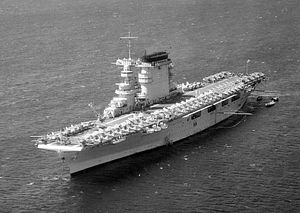Microsoft co-founder Paul Allen has made a hobby of searching for wrecks of World War II. Several years ago, his operation found HIJMS Musashi, a battleship sunk by American carrier aircraft during the Battle of Leyte Gulf; in August, R/V Petrel (Allen’s ship) found the wreck of the heavy cruiser USS Indianapolis, the ship that delivered the first atomic bomb. Now, Allen’s team has found USS Lexington, the first fast aircraft carrier to join the U.S. Navy (USN). Lexington was sunk on May 8, 1942.
Initially designed as a battlecruiser, USS Lexington was converted to an aircraft carrier under the terms of the 1922 Washington Naval Treaty. During the interwar period, the USN used she and her sister Saratoga to develop its carrier doctrine. Lexington escaped the attack on Pearl Harbor, having been dispatched to ferry aircraft to Midway Island. The first few months of the war were taken up by patrols and minor raids. In March and April, U.S. and British intelligence revealed a major Japanese operation in the South Pacific. U.S. commanders deduced the likelihood of an amphibious attack on Port Moresby, which would threaten to cut communications between the United States and Australia. Admiral Chester Nimitz deployed his available carriers (USS Lexington and USS Yorktown) to the region in order to stop the Japanese advance.
The result was the Battle of Coral Sea, the first carrier battle in history. Lexington and Yorktown intercepted a force consisting of two fleet (Shokaku and Zuikaku) and one light carriers. On the morning of May 7, aircraft from Lexington and Yorktown found and destroyed HIJMS Shoho, the first Japanese carrier sunk during the war. Aircraft from the main bodies of the two fleets found each other on May 8. American aircraft inflicted severe, but non-fatal, damage on HIJMS Shokaku. In return, the Japanese hit Lexington with two torpedoes and two bombs, and also damaged Yorktown. Although damage-control parties restored Lexington’s flight deck to service, a series of explosions ripped through the ship in the early afternoon. When the fires became uncontrollable, the ship was declared a total loss and abandoned. Five torpedoes from an escorting destroyer sent USS Lexington to the bottom, where she rested, undisturbed, until last week.
Despite the loss of Lexington, U.S. forces turned back the Japanese invasion of Port Moresby, dealing the Imperial Japanese Navy its first major setback of the war. The USN learned much from the sinking of Lexington, in particular regarding damage control practices and the dangers of flammable fumes spreading through a damaged ship. These lessons would help save carriers in future battles, such as USS Enterprise on several occasions, and USS Franklin in 1945.
Fortunately, at 3000 meters, USS Lexington is probably too deep to suffer the attention of the wreck salvagers who have destroyed many of the remaining artifacts of the Pacific War. She appears to be well-preserved, with gun mounts and even aircraft in good condition. Along with the other vessels that Allen has discovered, as well as those that remain unfound, she sits as a monument to the sacrifices made during the Pacific War.

































